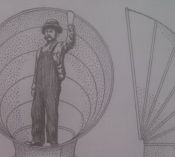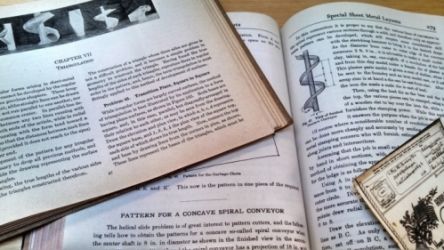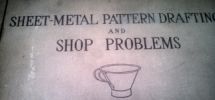 Last month, my dad brought in some books that mean a lot to me.
Last month, my dad brought in some books that mean a lot to me.
First you ought to know that this sheet metal thing is in my genes. I’ve been at Stevenson Company for 20-some years. My dad owned the place before I arrived, and my grandfather worked here even before that. He lived five blocks from the shop. After he retired and we still worked, it was nice to buzz over to his house, where he had lunch waiting, along with some sage advice and the day’s news.
Pop is gone now, but while sorting through his tools and other belongings Dad uncovered these dusty old apprenticeship books. The inside flap has the address of his temporary U.S. Army station in Germany, sent compliments of Topeka Trade School.
Way back when, Pop went to war and took his apprenticeship books soon followed. His most recent volume is dated 1942, and was intended for use in the field instead of the classroom, with plenty of diagrams and explanation, sort of a study abroad program. At a whopping 1,100 pages, it boasts in old-timey print that this is “a practical, illustrated treatise covering all phases of sheet metal work including pattern cutting and development for all sheet metal workers, layout men, mechanics and artisans.” Makes our trade sound kind of sexy, doesn’t it?

Just the kind of reading one would relish while on break from saving the world during WWII. Page 133 shows a boat cowling like Bugs Bunny springs from. Oh look, here’s a pattern for a “Concave, so-called Spiral, such as is used as a conveyor for fertilizing compounds, flax and cotton seed and grains, white lead, concrete, and many other materials.” Funny, the basic pattern layout endures, although we use different fabrication methods. For example, this instructions begins, “First it is advisable to make a small model of clay...and from this clay model make a female die of plaster of paris. This plaster paris model is given a coat of shellac, when it can be sent to the foundry and an iron cast. After having the iron die made a male die is cast of lead.” Pique your interest yet? It all comes together. “Then, using the lead die as the base and the iron die as the top, the various pieces can be stamped using a hard piece of wooden slat to lay over the iron die while a small sledge furnishes the stamping power.” Awesome, I want to make a YouTube video of this process. “While this method is crude, it answers the purpose when the job is small.” Ha, here’s a picture of a Spiral Chute wrapped around a newel post like “It’s a Wonderful Life.”
 Okay, I won’t bore you with the how-to, but suffice to say we have come a long way in the last seventy years. You can rest assured that we don’t use lead, only sanitary stainless steel. And we’ve gone from from handling cotton seed to conveying delicate food products. Fascinating reading to me, too, while taking a break from saving the world …. from broken potato chips.
Okay, I won’t bore you with the how-to, but suffice to say we have come a long way in the last seventy years. You can rest assured that we don’t use lead, only sanitary stainless steel. And we’ve gone from from handling cotton seed to conveying delicate food products. Fascinating reading to me, too, while taking a break from saving the world …. from broken potato chips.
Thanks Dad, for gifting these treasures. And Pop for forging the family trade.
-- Joe Pennington
President, Stevenson Company Inc.
